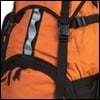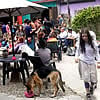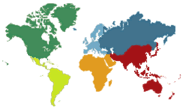Five weeks after Nepal was rocked by successive earthquakes, officials at Chabad say they’re using Talmudic logic to help them determine who to help first.
“There are tens of thousands of people—families of grandparents, parents, children and little babies—all sleeping in the streets, desperate for water and a warm meal,” reports Rabbi Chezky Lifshitz, co-director of Chabad of Nepal with his wife, Chani. “With so many people in such dire need, how do you possibly decide who to help first?”
The answer, he says, lies in the “Code of Jewish Law” (Y.D. 251:3), which advises the giver that “the poor of his family precede the poor of his city, and the poor of his city take precedence over the poor of another city.”
“This principle of concentric circles has been our guiding light since the quake,” explains the rabbi, who with his wife has been in Nepal since 1999. “Our first priority was to care for and house the hundreds of Israeli tourists, those who flocked to the Chabad House in Kathmandu and those stranded all over the country.
“As soon as we were able to,” he says, “we expanded our efforts to include the locals—the people we’ve come to know and appreciate during the more than 15 years that we have been living here: our neighbors, acquaintances, and especially, the Nepali people employed by the Chabad House.”
The Jewish Coalition for Disaster, coordinated by American Jewish Joint Distribution Committee (JDC), has been an important source of financial support for Chabad's emergency relief activities in Nepal. Lifshitz expressed his gratitude, saying “We are deeply moved by the outpouring of support from around the world. The support of the JDC and the Jewish Coalition for Disaster is helping us provide this crucial emergency relief.”
Tourists to Neighbors to Far-Flung Villagers
For example, when Didi, a cleaner at the Chabad House, informed the rabbi and his team that her home and the houses of her neighbors had been flattened, leaving them to sleep on the streets, Chabad’s team of volunteers put up sturdy, weather-proof tents to serve as roofs over their heads until permanent housing can be built—something the rabbi says he hopes to do in the near future.

Now, he says, convoys are being regularly dispatched to far-flung villages that have been decimated by the quake. “We come with truckloads of food, water, blankets, medications and tents,” he reports. “We listen to their troubles, determine their needs and try to supply them accordingly.”
“It is my heartfelt prayer to G‑d,” he concludes, “that we should always be surrounded by concentric circles of giving and love—not just in times of suffering, but in times of joy, plenty and celebration!”
Chabad of Nepal is collecting donations to help purchase much-needed supplies, especially tents, before the monsoon season hits. To help with the earthquake relief effort, visit the special relief fund page: www.Chabad.org/Nepal.





















Join the Discussion